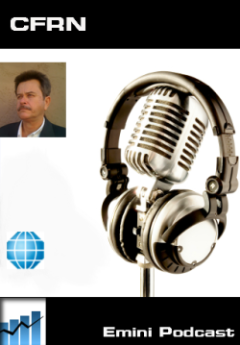(QQQ)(SPY)(SPX)(DIA)(GLD)
 Why Are Emini Futures So Popular?
Why Are Emini Futures So Popular?
If you've discovered Emini Futures, you're already way ahead of most Traders. The question then becomes "Which one should I choose?" For some people the term "Emini" means only one thing, the S&P 500. While it is by far the most popular and heavily traded of the Index Futures, it is not the only one.
On most trading platforms the symbol for the S&P Emini is ES. If you have the CME data feed on your platform, you also have access to the other Emini products. The Dow symbol is YM, the Russell is RTY, the Nasdaq is NQ. All four markets begin their trading session at 6PM Eastern and end the following day at 5PM eastern. As an example, the Monday session begins Sunday night at 6PM and closes Monday night at 5PM. The Tuesday session begins Monday night at 6PM, and so on...
The ability to trade around the clock from 6PM Sunday until 5PM Friday is one of the reasons Emini Futures are so wildly popular. Another of the many reasons is the cost of doing business. If you're new to Emini trading and aren't quite sure exactly what the term Margin is, the following should help.
Futures margin is the amount of money that you must deposit and keep on hand with your broker when you open a futures position. It is not a down payment and you do not own the underlying commodity.
Futures margin generally represents a smaller percentage of the notional value of the contract, typically 3-12% per futures contract as opposed to up to 50% of the face value of securities purchased on margin.
Daytrading Margins
Most Brokers offer special margin rates for all Emini markets, not just the S&P. The average margin requirement for the day session which in most cases includes trading overnight on Globex is $500. Typically you will only be required to post full margin if you hold a trade open from one session to the next. If you are flat when Globex trading begins at 6PM, even the trades you place on the overnight session still qualify for the advertised "day rate".
Check with your personal broker to make sure you understand the cost, and risk, before placing trades. Here is a list of margin requirements straight from the CME:
CME Maintenance Margin Requirements:
- S&P 500 Emini (ES) $6,300.00
- Dow Emini (YM) $6,050.00
- Russell Emini (RTY) $3,575.00
- Nasdaq Emini (NQ) $7,600.00
Again, most brokers do offer "special rates" for Day Traders. Without a doubt, this is the best kept secret in the world of trading. One S&P 500 Emini Contract has a notional value which is calculated as follows:
Current Value of Index (2,970 as of 5PM EDT 10/11/91) Multiplied by Point Value (ES pays $50 per point)
$2,970.00 X $50 = $148,500
As unbelievable as it may seem, it's true. For $500 you control $148,500.00 of S&P 500 best of breed equity. Trading 1 ES contract, when the value of the index changes by 1 Point you either earn, or lose, $50. If you've been around a bit, you've probably heard the call of the wild which says "capture just 2 points a day in the ES and earn as much money as you want". However, at $50 per point that's only $100 a day, correct? Correct!
Multiple Contracts
If 1 contract and 2 points only earns you $100 a day, why is that a great thing? As traders gain experience and build their account size, they increase the number of contracts they trade at one time. Using the same math, 2 contracts can bring home $200 per day, 3 contracts $300 etc... Once you reach 5 contracts the numbers start to look more appealing. At 10 contracts the same 2 points are now worth $1,000 a day.
Caution
One of the most tragic mistakes new traders make is trading too many contracts too soon. Don't do it. If you want to learn how to trade for a living, slow and steady wins the race. Our Traders have a blueprint designed to grow your trading business from 1 contract to 20 over 24 months. Slow and steady!
Bottom Line Cost
Math is the only "easy" thing about trading. If your broker offers you a $500 day trade margin, to trade 10 contracts at one time is $5K. Based on the current value of the S&P 500 Index mentioned above, 10 contracts multiplied by 2,970 multiplied by $50 = $1,485,000.00. The bottom line in this example has you controlling just shy of $1.5 million dollars for $5K. Let that sink in.
You may be more familiar with buying a home than an Emini contract. To control a piece of real estate valued at $1.5M, typically requires a minimum 10% down payment or $150K. Hopefully, you now better understand my remark about the "best kept secret" in the world of trading
Self Control - Resisting The Urge
If you are serious about learning to trade for a living, don't allow the "low barrier to entry" to become the very thing that destroys you. Our Traders first "earn" the right to trade real money in the simulator. Once they go "live" the blueprint requires you to increase your account balance by $2K before adding an additional contract. By exercising self-discipline, our Traders only add one contract at a time, and it is always underwritten by profits you've earned in the market.
Are All Emini Contracts Created Equal?
No. We covered the ES which pays $50 per point. The Dow (YM) pays $5 per point. The Nasdaq (NQ) pays $20 per point. The Russell (RTY) pays $50 per point just like the ES, but the structure is different. The smallest increment of movement in Futures is called a "tick" One ES point consists of 4 ticks, each valued at $12.50 per tick. The Russell which has the same point value ($50), consists of 10 ticks each valued at $5 per tick. One $20 point in the Nasdaq (NQ) consists of 4 ticks, each valued at $5 per tick. One Dow (YM) point is valued at $5 and that is the smallest increment, no ticks.
Valuation is computed the same way for each one. Index Value X Point Value = Notional Value.
Which Emini Is The Best To Trade?
All of them. Initially you are best to pick just one and stick with it until you gain a basic understanding of how markets work. You also need to learn the rules based strategy you are going to use. An argument can be made for each Emini market, but since you will be trading in the simulator until you are consistently profitable, just pick one. For a variety of reasons most Traders seem to pick the ES. Once again, just pick one and get to know and understand the ebb and flow, or the "rhythm of the market" as we call it, in whatever time frames your mechanical strategy dictates.
Different Strategies for Different Markets
This is where you will find lots of "opinions". Many of the voices will tell you something along these lines: "Each market has a unique personality so you will need a different strategy and different indicators for each one". That line is most often repeated by vendors who just so happen to have exactly what you need. A different course, strategy, and indicators for every market. Ka-ching!
While I don't deny different markets may have unique personalities, we utilize one strategy, and one indicator set to trade all markets. In fact, not only do we trade the ES / YM / NQ and RTY exactly the same, we use the exact same methodology and indicators to trade Gold / Crude / Bonds / Euro / Soybeans, even Equities. Everything!
Our indicators are fluid across all markets and all time frames.No matter what market or time frame you apply them to, their job is the same, identify the underlying rhythm of that market, in that time frame, and highlight the Low Risk - High Probability Setups.
Trading's Not Easy But It Can Be Simple!
To become a successful trader, you must have a definable edge. No matter what you hear, this is a business based on probabilities. No man, machine, indicator, or algorithm, can know the future. God in his infinite wisdom chose not to give Adam the ability to change the past or know the future, and the two are inextricably linked for eternity.
I know there are many websites that will try to convince you otherwise. You inbox is filled daily with reports of a new indicator, oscillator, or strategy, that has finally given mankind something God didn't sign off on. Be careful out there. You have no reason to believe me over anyone else, so once you figure it out for yourself, just remember you heard it here first.
The Next High Probability Move
There is a distinct difference between "knowing the future with certainty", and knowing what the next High Probability move is. We've been teaching Traders how to discern the next high probability move since 2005. Because knowing the future is so seductive, many Traders simply refuse to believe it. Until they run out of both time and treasure and forced to accept is as fact.
If you want to shave years off the learning curve and potentially save tens of thousands of dollars in the process, spend the next 5 Trading Days in our Live Training Room, absolutely FREE! Learn our Methodology, use our Indicators, and see what really is possible in the world of Emini Futures Trading.
Visit Emini Training School and register. No credit card required!
You must read all CFRN Disclaimers and Disclosures before taking the Free Trial or using any CFRN Product.
Emini - The Best Market To Choose
 January 25, 2021 at 9:54 PM
January 25, 2021 at 9:54 PM 










